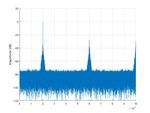geppetto
Newbie level 3
Input related tones in an ideal ADC
Hi everyone.
I was trying to build an ideal 3-bit ADC model using MATLAB simulink.
However when I increased the number of points, I found input related tones appeared in the spectrum as below.
(2^18 point FFT, Sampling frequency = 200M, Input frequency = 20M with coherent sampling condition is satisfied)
Of course those amplitudes are well below the target SNDR. (ENOB is calculated as nearly 3-bit)
It may not be a problem but when it is over-sampled, these tones will limit the achievable ENOB.
I also checked with the cadence using ideal 3-bit veriloga codes but the results are exactly same.
Can anyone help me to understand why these tones are appeared?

Hi everyone.
I was trying to build an ideal 3-bit ADC model using MATLAB simulink.
However when I increased the number of points, I found input related tones appeared in the spectrum as below.
(2^18 point FFT, Sampling frequency = 200M, Input frequency = 20M with coherent sampling condition is satisfied)
Of course those amplitudes are well below the target SNDR. (ENOB is calculated as nearly 3-bit)
It may not be a problem but when it is over-sampled, these tones will limit the achievable ENOB.
I also checked with the cadence using ideal 3-bit veriloga codes but the results are exactly same.
Can anyone help me to understand why these tones are appeared?

Last edited: